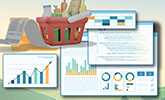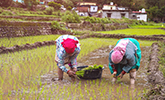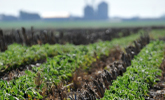Newsroom
See what's new and what's trending from ERS.
Spotlight
New from ERS
-

USDA Reschedules Reports Affected by Lapse in Federal Funding
ERS provides updates to the schedule of reports that were affected by the lapse in federal funding.
-

Farm Labor Expenses: Evidence from the 1997–2022 Census of Agriculture Data
This report explores U.S. farm labor expenses using Census of Agriculture data, which when adjusted for inflation, reveal that total farm labor expenses have increased in real terms from 1997 to 2022. Topics examined include changes in labor intensity, expense totals by State, contract labor’s share of total labor expenses, and the distribution of labor expenses by farm size.
-

U.S. Horticultural Imports From Mexico: 14 Years of Expansion From 2007–09 to 2021–23
This economic brief explores changes in U.S. horticultural imports from Mexico between 2007–09 and 2021–23. These imports grew significantly during the period studied, boosting U.S. per capita availability of a wide range of fresh produce. In real terms (2023 dollars), U.S. horticultural imports from Mexico grew from an annual average of $7.3 billion during 2007–09 to $19.7 billion during 2021–23. Imports increased for all 20 of the leading horticultural imports from Mexico.
-

Documentation for the Agri-Food Economic Data System (Ag-FEDS): A More Complete Accounting of the U.S. Agri-Food Economy
This report introduces the Agri-Food Economic Data System (Ag-FEDS), an integrated system of economic data that elaborates the linkages between all production and consumption activities throughout the economy, and shares details of the models and assumptions supporting the new tool.
-

Drivers of Fertilizer Markets: Supply, Demand, and Prices
U.S. fertilizer production and consumption—crucial for the productivity of U.S. agriculture—take place within a global fertilizer market. While global production and trade in fertilizer have increased, the U.S. share of world fertilizer production, imports, and exports have each declined by 25 percent or more since 2006. This study analyzes U.S. fertilizer production, consumption, and trade from 2006 (the last full year preceding the Great Recession) to 2023.
-

Global Food Assessment, 2025–35
This report focuses on food demand and availability in 83 countries. In 2025, an estimated 13.5 percent of the population (604 million people) cannot afford the 2,100 calories per day needed for a healthy and active lifestyle. This is 26.7 percent lower than the 2024 estimate, due to higher incomes and lower inflation.
-

Linking Resource Flows to Economic Sectors in the United States
This technical bulletin presents a flexible accounting structure to measure annual resources (employment, energy, and freshwater) used throughout the U.S. economy by production activity. This research builds on past work by presenting an annual time series and advancing allocation metrics.
-

The Food and Nutrition Assistance Landscape: Fiscal Year 2024 Annual Report
The U.S. Department of Agriculture (USDA) administers 16 domestic food and nutrition assistance programs that affect the lives of millions of people and account for roughly two-thirds of USDA’s annual budget. Together, these programs totaled $142.2 billion in spending on food and nutrition assistance programs in fiscal year (FY) 2024 (October 1, 2023–September 30, 2024). This report provides an overview of program trends and policy changes in USDA’s largest domestic food and nutrition assistance programs through FY 2024 based on preliminary data from the USDA, Food and Nutrition Service (FNS).
-

United States and Global Macroeconomic Projections from 2024 to 2034
This report details the macroeconomic projections from 2024 to 2034, provides the state of the global economy, and an analysis of the influence of events over the past year in various regions and countries.
-

Economic Outcomes of Soil Health and Conservation Practices on U.S. Cropland
This report describes the complexity of producer decision making regarding soil health and conservation practices and provides new insights about the current rates of adoption and profitability of key practices in U.S. crop agriculture.
